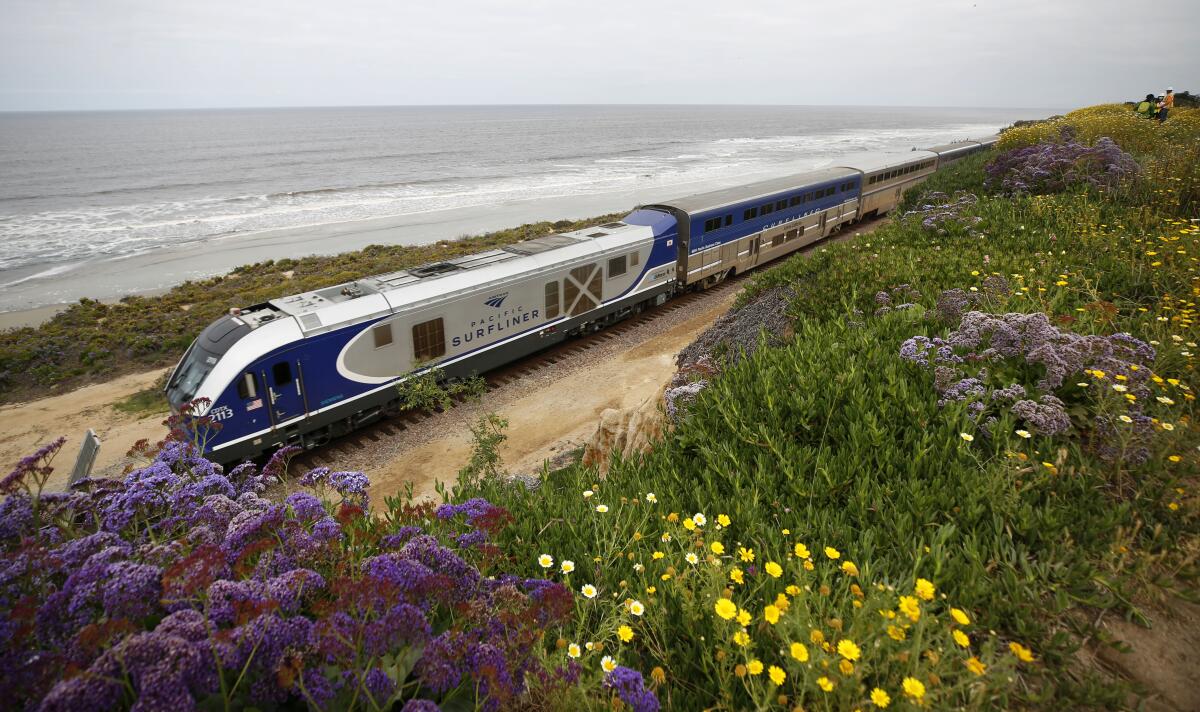Residents fight plan to fence coastal railroad tracks in San Diego County

- Share via
SAN DIEGO — The North County Transit District plans to install fences along miles of railroad track in three coastal cities by the end of 2020, a move many residents, especially those in Del Mar, have fought for years.
In a report released this month, NCTD said the 6-foot-tall, chain-link fence will be placed in areas where people most frequently trespass on the track, resulting in death or injury, damage to the railroad system or delays in service.
Transit officials say they don’t need the cities’ approvals to build the fence, but they have applied to a little-known federal agency — the Surface Transportation Board — to waive the need for oversight from Del Mar and the California Coastal Commission for the fence and other projects related to safety on the bluff-top tracks.
Many residents believe it’s their right to cross the railroad tracks, whether to get to the beach or simply to enjoy the view. Some of the most expensive homes in San Diego County are in Del Mar alongside the railroad tracks that hug the edge of the coast.
“I, as many surfers and beachgoers, access the beach via 11th Street in Del Mar,” said resident Camilla Rang, one of about 130 people who wrote letters to the transit district opposing the fence. “I do not want my access to be impeded by fencing on the bluff in Del Mar. As a resident of California, I have a constitutional right to access the beach.”
Rang and others said Del Mar residents were granted the right to cross the tracks by the Santa Fe Railroad deed in 1909, though the city incorporated only 60 years ago.
“We will never accept it,” Rang said in her letter. “We will fight to our last breath. We will scream and we will fight and we will win. The bluff and the beach is our backyard, has always been and will always be. It’s the train that should move, not us, and you know it.”
The transit district and regional planning agency the San Diego Assn. of Governments hope to eventually move the tracks away from the beach in Del Mar to an inland route. Such a relocation would cost more than $3 billion. Obtaining funding, along with other preliminary work, is expected to take at least 10 years, and construction would take another 10.
Meanwhile, coastal erosion and rising sea levels pose an increasing threat to the bluff-top tracks. Every year, there’s less room for people to walk along the tracks, and new slides threaten the railroad bed. NCTD and the association of governments are in the fourth phase of a six-part, multimillion-dollar effort to stabilize the Del Mar tracks where they are.
Fencing also is planned for the tracks in Oceanside and Encinitas, where the idea has been less of an issue because the railway there is not as close to the beach. But even though the tracks are a few blocks inland, people frequently cross illegally to get to the popular restaurants and bars along North Coast Highway in Encinitas’ Leucadia community.
Normally, coastal construction such as bluff repairs and fence installation requires approval from the California Coastal Commission and the local jurisdictions involved. However, in an attempt to bypass those approvals, NCTD in August filed a “petition for declaratory order” with the federal Surface Transportation Board asking the agency to waive the state and local permits.
Del Mar’s City Council some time ago voted to oppose fencing “that would mitigate tragic trespassing events and reduce ongoing delays to passenger and freight rail service,” the petition said. Additionally, it said, the transit district “has numerous crucial, upcoming rail maintenance and upgrading projects that will be challenged under the Coastal Act or local coastal laws.”
Del Mar and the San Diego chapter of the Surfrider Foundation have asked the federal agency to deny the transit district’s petition.
“In essence, NCTD asked for a waiver to indefinitely bypass state review processes that exist to ensure the proper management of coastal zone resources and ensure public access to our beaches,” states a response Surfrider posted to its website Oct. 8.
Del Mar, in its official reply to the NCTD petition, said the requested declaratory order is “inappropriate, unwise and unnecessary.”
“Despite its best efforts throughout its 168-page petition to try and manufacture one, NCTD fails to present an actual, present controversy or uncertainty that could be resolved by the issuance of a declaratory order,” stated the city’s response.
No date has been provided for a decision on the petition, according to NCTD spokeswoman Kimy Wall.
NCTD believes it has the right to construct the fence within the right-of-way, the strip of land the railroad uses for its tracks, with or without the declaratory order, Wall said.
In emergency situations, the transit district and San Diego Assn. of Governments have completed repairs without obtaining approval in advance. Last year, after a storm over the Thanksgiving weekend eroded the bluffs near the tracks, crews installed a retaining wall within a few days, then got permission months later from the Coastal Commission.
The petition to the Surface Transportation Board addresses broader issues in an effort to eliminate regulatory uncertainties about rail maintenance and upgrades, Wall said.
“NCTD’s railroad right-of-way is not a safe place for the general public,” she said in an emailed response to questions. “State law recognizes this by making it a violation to illegally cross the tracks.”
Fencing is one of a number of safety measures the district is installing to prepare for more frequent passenger and freight trains in years ahead, she said. The corridor, which saw 62 trains daily this year before the COVID-19 crisis, is expected to have 101 trains daily in 2030.
Cameras, lights, speakers and signs also will be added for safety. In all, the project is expected to cost between $2.4 million and $2.8 million.
The fence will be placed along the parallel right-of-way on both sides of the tracks for a 1.4-mile section of the corridor in Del Mar, south of the Coast Boulevard crossing.
In Encinitas, the fence will be placed between the four crossings in a 2.5-mile section between the Carlsbad border and the Encinitas train station. A few short sections of that corridor already have fencing.
In Oceanside, the chain-link barrier will be added to about three-quarters of a mile of the corridor that does not already have fencing south of the Oceanside Transit Center, with crossings at Loma Alta Marsh, Cassidy Street and Carlsbad Boulevard at the Buena Vista Lagoon.
Diehl writes for the San Diego Union-Tribune.
More to Read
Sign up for Essential California
The most important California stories and recommendations in your inbox every morning.
You may occasionally receive promotional content from the Los Angeles Times.










